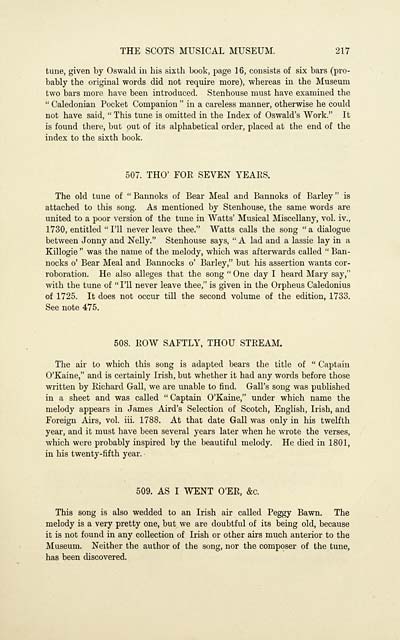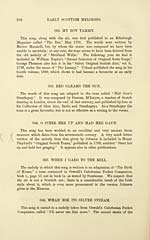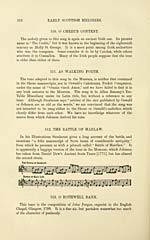Inglis Collection of printed music > Printed text > Early Scottish melodies
(239) Page 217 - Tho' for seven years
Download files
Complete book:
Individual page:
Thumbnail gallery: Grid view | List view

THE SCOTS MUSICAL MUSEUM. 217
tune, given by Oswald in his sixth book, page 16, consists of six bars (pro-
bably the original words did not require more), whereas in the Museum
two bars more have been introduced. Stenhouse must have examined the
" Caledonian Pocket Companion " in a careless manner, otherwise he could
not have said, " This tune is omitted in the Index of Oswald's Work." It
is found there, but out of its alphabetical order, placed at the end of the
index to the sixth book.
507. THO' FOE SEVEN YEAES.
The old tune of " Bannoks of Bear Meal and Bannoks of Barley " is
attached to this song. As mentioned by Stenhouse, the same words are
united to a poor version of the tune in Watts' Musical Miscellany, vol. iv.,
1730, entitled " I'll never leave thee." Watts calls the song " a dialogue
between Jonny and Nelly." Stenhouse says, " A lad and a lassie lay in a
Killogie " was the name of the melody, which was afterwards called " Ban-
nocks o' Bear Meal and Bannocks o' Barley," but his assertion wants cor-
roboration. He also alleges that the song " One day I heard Mary say,"
with the tune of " I'll never leave thee," is given in the Orpheus Caledonius
of 1725. It does not occur till the second volume of the edition, 1733.
See note 475.
508. EOW SAFTLY, THOU STEEAM.
The air to which this song is adapted bears the title of " Captain
O'Kaine," and is certainly Irish, but whether it had any words before those
written by Kichard Gall, we are unable to find. Gall's song was published
in a sheet and was called " Captain O'Kaine," under which name the
melody appears in James Aird's Selection of Scotch, English, Irish, and
Foreign Airs, vol. hi. 1788. At that date Gall was only in his twelfth
year, and it must have been several years later when he wrote the verses,
which were probably inspired by the beautiful melody. He died in 1801,
in his twenty-fifth year.
509. AS I WENT O'EE, &c.
This song is also wedded to an Irish air called Peggy Bawn. The
melody is a very pretty one, but we are doubtful of its being old, because
it is not found in any collection of Irish or other airs much anterior to the
Museum. Neither the author of the song, nor the composer of the tune,
has been discovered.
tune, given by Oswald in his sixth book, page 16, consists of six bars (pro-
bably the original words did not require more), whereas in the Museum
two bars more have been introduced. Stenhouse must have examined the
" Caledonian Pocket Companion " in a careless manner, otherwise he could
not have said, " This tune is omitted in the Index of Oswald's Work." It
is found there, but out of its alphabetical order, placed at the end of the
index to the sixth book.
507. THO' FOE SEVEN YEAES.
The old tune of " Bannoks of Bear Meal and Bannoks of Barley " is
attached to this song. As mentioned by Stenhouse, the same words are
united to a poor version of the tune in Watts' Musical Miscellany, vol. iv.,
1730, entitled " I'll never leave thee." Watts calls the song " a dialogue
between Jonny and Nelly." Stenhouse says, " A lad and a lassie lay in a
Killogie " was the name of the melody, which was afterwards called " Ban-
nocks o' Bear Meal and Bannocks o' Barley," but his assertion wants cor-
roboration. He also alleges that the song " One day I heard Mary say,"
with the tune of " I'll never leave thee," is given in the Orpheus Caledonius
of 1725. It does not occur till the second volume of the edition, 1733.
See note 475.
508. EOW SAFTLY, THOU STEEAM.
The air to which this song is adapted bears the title of " Captain
O'Kaine," and is certainly Irish, but whether it had any words before those
written by Kichard Gall, we are unable to find. Gall's song was published
in a sheet and was called " Captain O'Kaine," under which name the
melody appears in James Aird's Selection of Scotch, English, Irish, and
Foreign Airs, vol. hi. 1788. At that date Gall was only in his twelfth
year, and it must have been several years later when he wrote the verses,
which were probably inspired by the beautiful melody. He died in 1801,
in his twenty-fifth year.
509. AS I WENT O'EE, &c.
This song is also wedded to an Irish air called Peggy Bawn. The
melody is a very pretty one, but we are doubtful of its being old, because
it is not found in any collection of Irish or other airs much anterior to the
Museum. Neither the author of the song, nor the composer of the tune,
has been discovered.
Set display mode to: Large image | Transcription
Images and transcriptions on this page, including medium image downloads, may be used under the Creative Commons Attribution 4.0 International Licence unless otherwise stated. ![]()
| Special collections of printed music > Inglis Collection of printed music > Printed text > Early Scottish melodies > (239) Page 217 - Tho' for seven years |
|---|
| Permanent URL | https://digital.nls.uk/94646140 |
|---|---|
| Description | Also: Row saftly, thou stream. Also: As I went o'er. |
| Description | Scottish and English songs, military music and keyboard music of the 18th and 19th centuries. These items are from the collection of Alexander Wood Inglis of Glencorse (1854 to 1929). Also includes a few manuscripts, some treatises and other books on the subject. |
|---|
| Description | The Glen Collection and the Inglis Collection represent mainly 18th and 19th century Scottish music, including Scottish songs. The collections of Berlioz and Verdi collected by bibliographer Cecil Hopkinson contain contemporary and later editions of the works of the two composers Berlioz and Verdi. |
|---|

